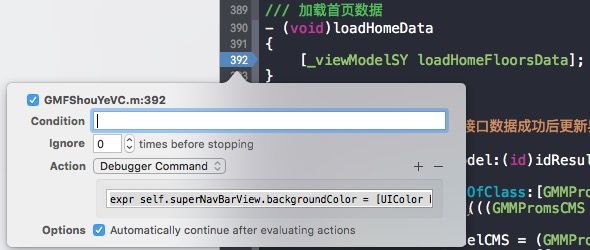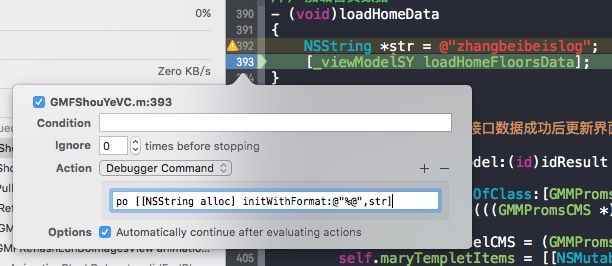一、常用的命令
1.print、po输出打印
打印变量的值可以使用print(简写p)命令,该命令如果打印的是基础数据类型,则会列出基础数据类型的类型和值。如果是对象,还会打印出对象指针地址,如下所示:
(lldb) p str
(__NSCFConstantString *) $1 = 0x000000010c14e068 @"我是一个普通的字符串"
(lldb) p intDemo
(NSInteger) $2 = 2
(lldb)
print命令输出的信息中带有 $0 、 $1的字样。我们可以将它看作是lldb内部的变量,我们可以在后面的查询中直接使用这些值。比如现在我要重新取回 $1 的值(或者调用$1的方法都是可以的,注意在使用lldb内部的变量$来记录变量的时候,没有语法提示,所以你需要自己能准确的打印出方法的名字,或者在Xcode编辑器中去打好方法,然后再拷贝到lldb处)
(lldb) p $1
(__NSCFConstantString *) $1 = 0x000000010c14e068 @"我是一个普通的字符串"
每打印一个与对象相关的命令,$后面的值都会加1
print的打印信息较多,如果只想查看对象的值,则可以使用po(printobject)命令,如下所示:
(lldb) po str
我是一个普通的字符串
(lldb) po intDemo
2
对于基础数据类型,还可以指定格式打印,如用16进制的格式打印:
(lldb) p/x intDemo
(NSInteger) $14 = 0x0000000000000002
其他格式(如:八进制,二进制等)不做过多说明,感兴趣可以自己研究。
上面的例子是比较简单的,在实际开发中的应用是非常广泛的,如,打印self.view所有的子view,查看某个子view的描述等等。
2.call
call调用方法的意思,和p,po也有此功能,call可以使用在没有返回值,不需要显示输出的情况下,如设置view颜色
(lldb) call [self.view setBackgroundColor:[UIColor redColor]]
这样就不用为了看改一下颜色的效果再进行build一次了,尤其是build一次还要经过漫长的等待。
3.expression表达式(expr)
expr常用于调试时修改变量的值,如进入商品详情页之后,我想使用一个测试商品进行测试,这时,不需要修改代码再重新编译就可以看到效果,来试验一下。我在viewDidLoad中打一个断点,进入商品详情页,到断点位置后,输入expr命令来修改 productId·和skuId,然后继续运行,OK了,省去了写测试代码和编译的时间,事半功倍有没有!
(lldb) expr self.productId = @"A0000001076"
(__NSCFString *) $0 = 0x00007ffc78a8f300 @"A0000001076"
(lldb) expr self.currentSkuId = @"sku10210013"
(__NSCFString *) $1 = 0x00007ffc790610c0 @"sku10210013"
它的作用不仅仅是修改变量的值,你加其他功能的代码也是可以的,只要是和上下文相关的一句代码就OK,如:初始化导航栏之后,我想修改一下它的颜色,看一下效果,如下:
(lldb) expr self.superNavBarView.backgroundColor = [UIColor redColor]
(UICachedDeviceRGBColor *) $3 = 0x00007ffc783d0290
注意:表达式之后不需要加分号,加了分号之后会报错
4.image
(1)image lookup --address寻址,定位异常代码位置
举例说明,下面这段代码,执行的时候必然会出现异常,因为越界了
NSString *str = @"245656";
[str substringFromIndex:10];
控制台输出了以下崩溃信息:
2016-05-27 14:58:54.173 GomeEShop[61425:4544758] *** Terminating app due to uncaught exception 'NSRangeException', reason: '*** -[__NSCFConstantString substringFromIndex:]: Index 10 out of bounds; string length 6'
*** First throw call stack:
(
0 CoreFoundation 0x000000010e99ad85 __exceptionPreprocess + 165
1 libobjc.A.dylib 0x000000011360ddeb objc_exception_throw + 48
2 CoreFoundation 0x000000010e99acbd +[NSException raise:format:] + 205
3 Foundation 0x000000010f8698bd -[NSString substringFromIndex:] + 126
4 GomeEShop 0x00000001097c396f -[GMFPTGoodsDetailVC initNecessaryViews] + 3903
5 GomeEShop 0x00000001097c1c51 -[GMFPTGoodsDetailVC viewDidLoad] + 369
6 UIKit 0x00000001110ae984 -[UIViewController loadViewIfRequired] + 1198
7 UIKit 0x00000001110b493b -[UIViewController __viewWillAppear:] + 120
8 UIKit 0x00000001110e4750 -[UINavigationController _startCustomTransition:] + 1203
9 UIKit 0x00000001110f4b9b -[UINavigationController _startDeferredTransitionIfNeeded:] + 712
10 UIKit 0x00000001110f5d0b -[UINavigationController __viewWillLayoutSubviews] + 57
11 UIKit 0x00000001112a4503 -[UILayoutContainerView layoutSubviews] + 248
12 UIKit 0x0000000110fce980 -[UIView(CALayerDelegate) layoutSublayersOfLayer:] + 703
13 QuartzCore 0x0000000110c85c00 -[CALayer layoutSublayers] + 146
14 QuartzCore 0x0000000110c7a08e _ZN2CA5Layer16layout_if_neededEPNS_11TransactionE + 366
15 QuartzCore 0x0000000110c79f0c _ZN2CA5Layer28layout_and_display_if_neededEPNS_11TransactionE + 24
16 QuartzCore 0x0000000110c6e3c9 _ZN2CA7Context18commit_transactionEPNS_11TransactionE + 277
17 QuartzCore 0x0000000110c9c086 _ZN2CA11Transaction6commitEv + 486
18 UIKit 0x0000000110f4019b _afterCACommitHandler + 174
19 CoreFoundation 0x000000010e8bfc37 __CFRUNLOOP_IS_CALLING_OUT_TO_AN_OBSERVER_CALLBACK_FUNCTION__ + 23
20 CoreFoundation 0x000000010e8bfba7 __CFRunLoopDoObservers + 391
21 CoreFoundation 0x000000010e8b57fb __CFRunLoopRun + 1147
22 CoreFoundation 0x000000010e8b50f8 CFRunLoopRunSpecific + 488
23 GraphicsServices 0x000000011481bad2 GSEventRunModal + 161
24 UIKit 0x0000000110f13f09 UIApplicationMain + 171
25 GomeEShop 0x00000001091c0ebf main + 111
26 libdyld.dylib 0x0000000113ba992d start + 1
)
libc++abi.dylib: terminating with uncaught exception of type NSException
通过异常信息,我们看到崩溃很可能发生在-[GMFPTGoodsDetailVCinitNecessaryViews]方法中,也就是地址0x00000001097c396f,我们输入以下命令来进行精确定位
(lldb) image lookup --address 0x00000001097c396f
执行后输出以下信息
Address: GomeEShop[0x00000001006af96f] (GomeEShop.__TEXT.__text + 7000239)
Summary: GomeEShop`-[GMFPTGoodsDetailVC initNecessaryViews] + 3903 at GMFPTGoodsDetailVC.m:589
我们看到出错的位置在GMFPTGoodsDetailVC.m文件中的initNecessaryViews方法中,第589行
(2)image lookup --type查看类型
我们还可以使用image lookup命令来查看具体的类型,如下所示:
(lldb) image lookup --type UIImage
执行后输出了UIImage所包含的属性
Best match found in /Users/zhangbeibei/Library/Developer/Xcode/DerivedData/GomeEShop-dhpyydtykrwzvpawiualtxfthsqy/Build/Products/Debug-iphonesimulator/GomeEShop.app/GomeEShop:
id = {0x00cabeb2}, name = "UIImage", byte-size = 8, decl = UIImage.h:53, compiler_type = "@interface UIImage : NSObject
@property ( readonly,getter = size,setter = ,nonatomic ) CGSize size;
@property ( readonly,getter = CGImage,setter = ,nonatomic ) CGImageRef CGImage;
@property ( readonly,getter = CIImage,setter = ,nonatomic ) CIImage * CIImage;
@property ( readonly,getter = imageOrientation,setter = ,nonatomic ) UIImageOrientation imageOrientation;
@property ( readonly,getter = scale,setter = ,nonatomic ) CGFloat scale;
@property ( readonly,getter = images,setter = ,nonatomic ) NSArray * images;
@property ( readonly,getter = duration,setter = ,nonatomic ) NSTimeInterval duration;
@property ( readonly,getter = capInsets,setter = ,nonatomic ) UIEdgeInsets capInsets;
@property ( readonly,getter = resizingMode,setter = ,nonatomic ) UIImageResizingMode resizingMode;
@property ( readonly,getter = alignmentRectInsets,setter = ,nonatomic ) UIEdgeInsets alignmentRectInsets;
@property ( readonly,getter = renderingMode,setter = ,nonatomic ) UIImageRenderingMode renderingMode;
@property ( readonly,getter = traitCollection,setter = ,copy,nonatomic ) UITraitCollection * traitCollection;
@property ( readonly,getter = imageAsset,setter = ,nonatomic ) UIImageAsset * imageAsset;
@property ( readonly,getter = flipsForRightToLeftLayoutDirection,setter = ,nonatomic ) BOOL flipsForRightToLeftLayoutDirection;
@end"
5.bt
我们可以用bt来打印调用堆栈,加all可打印多有thread的堆栈,如下图
(lldb) bt
* thread #1: tid = 0x4558f6, 0x0000000113eedf06 libsystem_kernel.dylib`__pthread_kill + 10, queue = 'com.apple.main-thread', stop reason = signal SIGABRT
frame #0: 0x0000000113eedf06 libsystem_kernel.dylib`__pthread_kill + 10
frame #1: 0x0000000113eb54ec libsystem_pthread.dylib`pthread_kill + 90
frame #2: 0x0000000113c4fcec libsystem_c.dylib`abort + 129
frame #3: 0x0000000113a4e051 libc++abi.dylib`abort_message + 257
frame #4: 0x0000000113a73ac9 libc++abi.dylib`default_terminate_handler() + 267
frame #5: 0x000000011360e046 libobjc.A.dylib`_objc_terminate() + 103
frame #6: 0x0000000113a7126e libc++abi.dylib`std::__terminate(void (*)()) + 8
frame #7: 0x0000000113a70ef9 libc++abi.dylib`__cxa_rethrow + 99
frame #8: 0x000000011360df5e libobjc.A.dylib`objc_exception_rethrow + 40
frame #9: 0x000000010e8b51b4 CoreFoundation`CFRunLoopRunSpecific + 676
frame #10: 0x000000011481bad2 GraphicsServices`GSEventRunModal + 161
frame #11: 0x0000000110f13f09 UIKit`UIApplicationMain + 171
* frame #12: 0x00000001091c0ebf GomeEShop`main(argc=1, argv=0x00007fff56aea5f8) + 111 at main.m:16
frame #13: 0x0000000113ba992d libdyld.dylib`start + 1
frame #14: 0x0000000113ba992d libdyld.dylib`start + 1
二、断点编辑
1.设置触发条件
我们在进行断点调试时,可以为断点设置触发条件,以便针对特定的数据进行分析,观察程序运行正常,如在首页的403行设置一个断点,触发条件是isCache为NO
这样当刷新数据且数据是从缓存中读取的时候,该断点生效
2.设置触发事件
在编辑断点时从Action选项列表中可以看到,断点的触发事件有AppleScript、Capture GPU Frame、Debugger Command、Log Message、Shell Command、Sound这几种。
Debugger Command
它和上述说的在控制台输入的命令是一样的,可以起到相同的效果,但是它的方便之处在于,如果你勾选了Automatically continue after evaluating actions,在断点处程序不会中断,会正常运行。不足之处是,输入命令时没有联想提示,不太方便。
如下图,在加载首页数据时的断点处,添加了命令expr self.superNavBarView.backgroundColor = [UIColor blueColor],再勾选上Automatically continue after evaluating actions,执行到此处的时候不会停止,而且导航栏的颜色变成了蓝色。
使用Debugger Command,再加po命令可以随心所欲的输出你需要的信息,而你就不用为了调试一个东西而加一句NSLog然后再重新编译一次看结果了,代码中也少了很多NSLog这样的语句,是不是简洁多了。
注意:经试验在这里输出格式化字符串时,不能使用[NSString stringWithFormat:@"%@",str],否则会报下面的错误,要使用上图中的[[NSString alloc] initWithFormat:@"%@",str]才可以,是不是有点怪
error: too many arguments to method call, expected 1, have 2
error: 1 errors parsing expression
Log Message
看字面意思就知道这个是输出log,在输入框中直接输入你想输出的内容接,比Debugger Command+po方便,但是它很直白,不能输出变量等信息,只能输出静态字符串,如下图,输出的内容就是输入的内容,不会被格式化
输出内容就是[[NSString alloc] initWithFormat:@"%@",str]
Sound
设置声音,当代码执行到断点处时,会有提示音,对我们来说不是经常用
其他几种就不做探究了,因为我也不是很懂,呵呵。。。
三、命令的简称和别名
1.简称
很多时候,LLDB完整的命令是很长的。比如前面所说的image lookup --address这个组合命令。为了方便日常的使用,提高效率,LLDB命令也提供通过简称的方式调用命令。如 image lookup —address这个 命令,可以简写为im loo -a,expression简写为expr,print简写为p等等,自己去发现吧。
2.别名
除了使用命令的简称外,对于不好记忆的命令,我们还可以为它设置别名,现在我们为imagelookup –address设置一个别名叫imgadd
输入命令:
command alias imgadd image lookup --address %1
然后再使用imgadd命令和imagelookup –address就是一样的了,不过我发现比较坑的是,重新编译一次工程后,设置的别名就不好使了,还是使用原名吧,在Xcode控制台输入命令时都会有联想提示,也比较方便
以上介绍的命令是比较常用的一些,然而lldb的命令远不只有这些,想知道还有哪些,输入help,查看一下
(lldb) help
Debugger commands:
apropos -- Find a list of debugger commands related to a particular
word/subject.
breakpoint -- A set of commands for operating on breakpoints. Also see
_regexp-break.
bugreport -- Set of commands for creating domain specific bugreports.
command -- A set of commands for managing or customizing the
debugger commands.
disassemble -- Disassemble bytes in the current function, or elsewhere
in the executable program as specified by the user.
expression -- Evaluate an expression (ObjC++ or Swift) in the current
program context, using user defined variables and
variables currently in scope.
frame -- A set of commands for operating on the current thread's
frames.
gdb-remote -- Connect to a remote GDB server. If no hostname is
provided, localhost is assumed.
gui -- Switch into the curses based GUI mode.
help -- Show a list of all debugger commands, or give details
about specific commands.
kdp-remote -- Connect to a remote KDP server. udp port 41139 is the
default port number.
language -- A set of commands for managing language-specific
functionality.'.
log -- A set of commands for operating on logs.
memory -- A set of commands for operating on memory.
platform -- A set of commands to manage and create platforms.
plugin -- A set of commands for managing or customizing plugin
commands.
process -- A set of commands for operating on a process.
quit -- Quit out of the LLDB debugger.
register -- A set of commands to access thread registers.
script -- Pass an expression to the script interpreter for
evaluation and return the results. Drop into the
interactive interpreter if no expression is given.
settings -- A set of commands for manipulating internal settable
debugger variables.
source -- A set of commands for accessing source file information
target -- A set of commands for operating on debugger targets.
thread -- A set of commands for operating on one or more threads
within a running process.
type -- A set of commands for operating on the type system
version -- Show version of LLDB debugger.
watchpoint -- A set of commands for operating on watchpoints.
Current command abbreviations (type 'help command alias' for more info):
add-dsym -- ('target symbols add') Add a debug symbol file to one of the
target's current modules by specifying a path to a debug symbols
file, or using the options to specify a module to download
symbols for.
attach -- ('_regexp-attach') Attach to a process id if in decimal,
otherwise treat the argument as a process name to attach to.
b -- ('_regexp-break') Set a breakpoint using a regular expression
to specify the location, where is in decimal and
is in hex.
bt -- ('_regexp-bt') Show a backtrace. An optional argument is
accepted; if that argument is a number, it specifies the number
of frames to display. If that argument is 'all', full
backtraces of all threads are displayed.
c -- ('process continue') Continue execution of all threads in the
current process.
call -- ('expression --') Evaluate an expression (ObjC++ or Swift) in
the current program context, using user defined variables and
variables currently in scope.
continue -- ('process continue') Continue execution of all threads in the
current process.
detach -- ('process detach') Detach from the current process being
debugged.
di -- ('disassemble') Disassemble bytes in the current function, or
elsewhere in the executable program as specified by the user.
dis -- ('disassemble') Disassemble bytes in the current function, or
elsewhere in the executable program as specified by the user.
display -- ('_regexp-display') Add an expression evaluation stop-hook.
down -- ('_regexp-down') Go down "n" frames in the stack (1 frame by
default).
env -- ('_regexp-env') Implements a shortcut to viewing and setting
environment variables.
exit -- ('quit') Quit out of the LLDB debugger.
f -- ('frame select') Select a frame by index from within the
current thread and make it the current frame.
file -- ('target create') Create a target using the argument as the
main executable.
finish -- ('thread step-out') Finish executing the function of the
currently selected frame and return to its call site in
specified thread (current thread, if none specified).
image -- ('target modules') A set of commands for accessing information
for one or more target modules.
j -- ('_regexp-jump') Sets the program counter to a new address.
jump -- ('_regexp-jump') Sets the program counter to a new address.
kill -- ('process kill') Terminate the current process being debugged.
l -- ('_regexp-list') Implements the GDB 'list' command in all of
its forms except FILE:FUNCTION and maps them to the appropriate
'source list' commands.
list -- ('_regexp-list') Implements the GDB 'list' command in all of
its forms except FILE:FUNCTION and maps them to the appropriate
'source list' commands.
n -- ('thread step-over') Source level single step in specified
thread (current thread, if none specified), stepping over calls.
next -- ('thread step-over') Source level single step in specified
thread (current thread, if none specified), stepping over calls.
nexti -- ('thread step-inst-over') Single step one instruction in
specified thread (current thread, if none specified), stepping
over calls.
ni -- ('thread step-inst-over') Single step one instruction in
specified thread (current thread, if none specified), stepping
over calls.
p -- ('expression --') Evaluate an expression (ObjC++ or Swift) in
the current program context, using user defined variables and
variables currently in scope.
po -- ('expression -O -- ') Evaluate an expression (ObjC++ or Swift)
in the current program context, using user defined variables and
variables currently in scope.
print -- ('expression --') Evaluate an expression (ObjC++ or Swift) in
the current program context, using user defined variables and
variables currently in scope.
q -- ('quit') Quit out of the LLDB debugger.
r -- ('process launch -X true --') Launch the executable in the
debugger.
rbreak -- ('breakpoint set -r %1') Sets a breakpoint or set of
breakpoints in the executable.
repl -- ('expression -r -- ') Evaluate an expression (ObjC++ or Swift)
in the current program context, using user defined variables and
variables currently in scope.
run -- ('process launch -X true --') Launch the executable in the
debugger.
s -- ('thread step-in') Source level single step in specified thread
(current thread, if none specified).
si -- ('thread step-inst') Single step one instruction in specified
thread (current thread, if none specified).
step -- ('thread step-in') Source level single step in specified thread
(current thread, if none specified).
stepi -- ('thread step-inst') Single step one instruction in specified
thread (current thread, if none specified).
t -- ('thread select') Select a thread as the currently active
thread.
tbreak -- ('_regexp-tbreak') Set a one shot breakpoint using a regular
expression to specify the location, where is in
decimal and is in hex.
undisplay -- ('_regexp-undisplay') Remove an expression evaluation
stop-hook.
up -- ('_regexp-up') Go up "n" frames in the stack (1 frame by
default).
x -- ('memory read') Read from the memory of the process being
debugged.
For more information on any command, type 'help '.
正如上述最后一句所说,想了解某个命令的更多信息,输入help +命令名即可
命令是不是太多了,想要熟练使用,就要多用多用再多用,熟练之后效率会有意想不到的提高!



